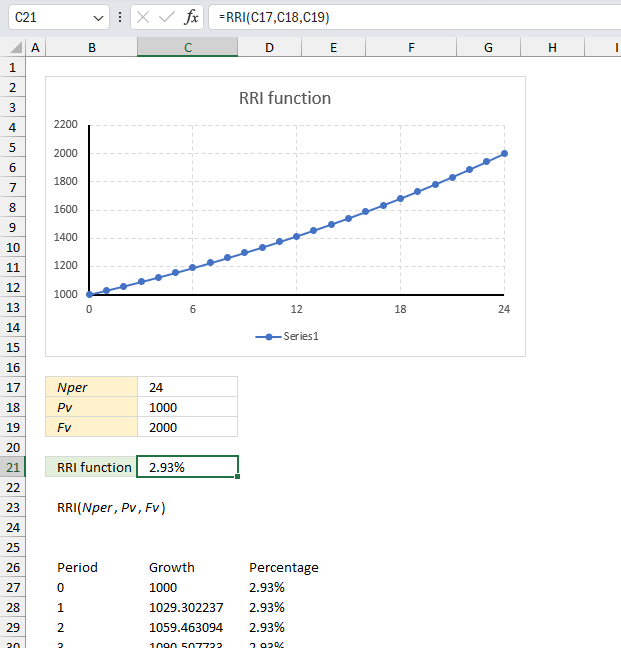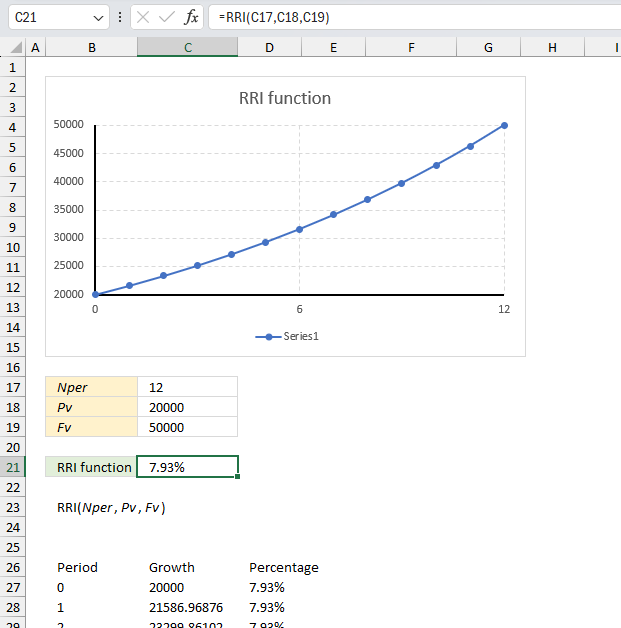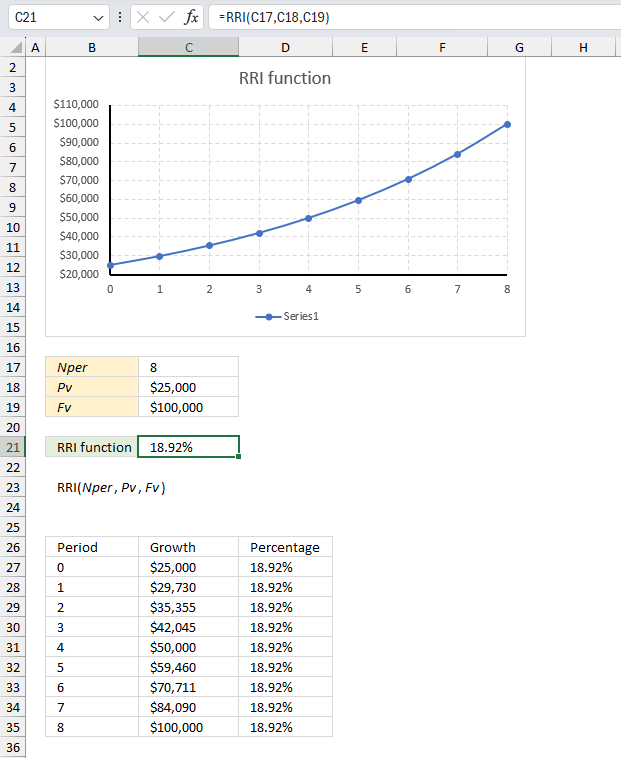How to use the RRI function

What is the RRI function?
The RRI function calculates the growth of an investment in percent per period.
Table of Contents
1. Introduction
What is the difference between the RRI function and the RATE function?
RRI calculates the net rate of return for an investment based on the invested value and future value.
RATE calculates the periodic interest rate required to achieve a certain future value from given cash flows, invested value, and future value.
RATE(nper, pmt, pv, [fv], [type])
RRI(Nper, Pv, Fv)
What is an investment?
An investment is an asset or business acquired with the goal of generating income or appreciation, the purpose is to grow the money over time.
What are periods?
A payment period is the length of time between payments made on a loan or investment. For example, a loan with monthly payments the payment period would be one month. A loan with quarterly payments the payment period would be three months.
What is present value?
The present value is the initial amount that will earn interest/dividend.
What is future value?
The compounded amount after the calculated periods based on the given rate. It measures what a current capital (present value) amount will be worth at a designated future date.
What are periodic constant payments?
Periodic constant payments are payments that are made at regular intervals such as monthly, quarterly, or yearly and have the same amount each time.
What is a constant interest rate?
A fixed interest rate is an interest rate that remains the same throughout the term of a loan or an investment.
What is the number of compounding periods per year?
The number of compounding periods per year refers to how often interest is compounded annually on an investment or loan.
Some common compounding periods:
- Annually - 1 compounding period per year
- Semiannually - 2 compounding periods per year
- Quarterly - 4 compounding periods per year
- Monthly - 12 compounding periods per year
- Weekly - 52 compounding periods per year
- Daily - 365 compounding periods per year
What is compounding?
Compounding refers to the process of generating more interest from interest that was previously earned. It causes interest to grow exponentially over time.
Related functions
| Function | Description |
|---|---|
| RATE(nper, pmt, pv, [fv], [type]) | Returns the interest rate per period of an annuity |
| PV(rate, nper, pmt, [fv], [type]) | Returns the present value of an investment. |
| FV(rate, nper, pmt, [pv], [type]) | Returns the future value of an investment. |
| PDURATION(rate, pv, fv) | Returns the periods needed for an investment to reach a future value. |
How is the RRI Function calculated?
RRI = (Fv/Pv)(1/nper)
Fv - future value
Pv - present value
nper - periods
The equivalent formula is:
2. Syntax
RRI(Nper, Pv, Fv)
| Nper | Required. Nper is the number of periods. |
| Pv | Required. Pv is the present value. |
| Fv | Required. Fv is the future value. |
3. Example 1

You have invested $1,000 in a fixed deposit account that promises to grow to $2,000 over 24 years. What is the rate of return per period for this investment?
The arguments are:
nper: 24 periods (years)
Pv: 1,000 (present value)
Fv: 2,000 (Future value)
The RRI function calculates the growth, in percent of a period, of an investment based on the future value.
Formula in cell C21:
The formula in cell C21 returns 2.93% which represents the growth per period for an investment of 1,000 to grow to a future value of 2,000 in 24 periods.
The math formula behind the RRI function is: RRI = (Fv/Pv)(1/nper)
Lets plug the argument values in this math formula and see what we get.
(2000/1000)(1/24)
becomes
2(1/24) equals 1.0293022366 This value matches the calculated value in cell C21.
4. Example 2

You want to save $50,000 for your child's college education in 12 years. If you start with an initial investment of $20,000, what rate of return per period do you need to achieve your goal?
The arguments are:
nper: 12 periods (years)
Pv: 20,000 (present value)
Fv: 50,000 (Future value)
The RRI function calculates the growth, in percent of a period, of an investment based on the future value.
Formula in cell C21:
The formula in cell C21 returns 7.93% which represents the growth per period for an investment of 20,000 to grow to a future value of 50,000 in 12 periods.
The math formula behind the RRI function is: RRI = (Fv/Pv)(1/nper)
Lets plug the argument values in this math formula and see what we get.
(50000/20000)(1/12)
becomes
2.5(1/12) equals 1.079348438 This value matches the calculated value in cell C21.
5. Example 3

You have the opportunity to invest in a startup that requires an initial investment of $25,000. The startup promises to return 4 times the initial value after 8 years. What is the rate of return per period for this investment?
The arguments are:
nper: 12 periods (years)
Pv: 20,000 (present value)
Fv: 100,000 (Future value)
The future value is 4 times larger than the initial investment. Formula in cell C19:
The RRI function calculates the growth, in percent of a period, of an investment based on the future value.
Formula in cell C21:
The formula in cell C21 returns 18.92% which represents the growth per period for an investment of 25,000 to grow to a future value of 100,000 in 8 periods.
The math formula behind the RRI function is: RRI = (Fv/Pv)(1/nper)
Lets plug the argument values in this math formula and see what we get.
(100000/25000)(1/8)
becomes
4(1/8) equals 1.01892 This value matches the calculated value in cell C21.
The table below the formula in cell C21 calculates the growth for each period starting with period 0 (zero) that has the initial investment. The formulas in cells B27, C27, and D27 are dynamic meaning they change automatically when the input values in cells C18, C18, and C19 changes.
Excel dynamic array formula in cell B27:
The formula in cell B27 calculates the number of periods based on input value in cell C17. It always starts with 0 (zero).
Excel dynamic array formula in cell C27:
The formula in cell C27 calculates how the initial investment grows, it shows the growth for each period.
Excel dynamic array formula in cell D27:
This formula repeats the percentage growth for each period.
6. Why is this function not working

The RRI function returns:
- #VALUE! error if arguments are not a valid data type.
- #NUM! error if the arguments are not valid.
6.1 Troubleshooting the error value

When you encounter an error value in a cell a warning symbol appears, displayed in the image above. Press with mouse on it to see a pop-up menu that lets you get more information about the error.
- The first line describes the error if you press with left mouse button on it.
- The second line opens a pane that explains the error in greater detail.
- The third line takes you to the "Evaluate Formula" tool, a dialog box appears allowing you to examine the formula in greater detail.
- This line lets you ignore the error value meaning the warning icon disappears, however, the error is still in the cell.
- The fifth line lets you edit the formula in the Formula bar.
- The sixth line opens the Excel settings so you can adjust the Error Checking Options.
Here are a few of the most common Excel errors you may encounter.
#NULL error - This error occurs most often if you by mistake use a space character in a formula where it shouldn't be. Excel interprets a space character as an intersection operator. If the ranges don't intersect an #NULL error is returned. The #NULL! error occurs when a formula attempts to calculate the intersection of two ranges that do not actually intersect. This can happen when the wrong range operator is used in the formula, or when the intersection operator (represented by a space character) is used between two ranges that do not overlap. To fix this error double check that the ranges referenced in the formula that use the intersection operator actually have cells in common.
#SPILL error - The #SPILL! error occurs only in version Excel 365 and is caused by a dynamic array being to large, meaning there are cells below and/or to the right that are not empty. This prevents the dynamic array formula expanding into new empty cells.
#DIV/0 error - This error happens if you try to divide a number by 0 (zero) or a value that equates to zero which is not possible mathematically.
#VALUE error - The #VALUE error occurs when a formula has a value that is of the wrong data type. Such as text where a number is expected or when dates are evaluated as text.
#REF error - The #REF error happens when a cell reference is invalid. This can happen if a cell is deleted that is referenced by a formula.
#NAME error - The #NAME error happens if you misspelled a function or a named range.
#NUM error - The #NUM error shows up when you try to use invalid numeric values in formulas, like square root of a negative number.
#N/A error - The #N/A error happens when a value is not available for a formula or found in a given cell range, for example in the VLOOKUP or MATCH functions.
#GETTING_DATA error - The #GETTING_DATA error shows while external sources are loading, this can indicate a delay in fetching the data or that the external source is unavailable right now.
6.2 The formula returns an unexpected value

To understand why a formula returns an unexpected value we need to examine the calculations steps in detail. Luckily, Excel has a tool that is really handy in these situations. Here is how to troubleshoot a formula:
- Select the cell containing the formula you want to examine in detail.
- Go to tab “Formulas” on the ribbon.
- Press with left mouse button on "Evaluate Formula" button. A dialog box appears.
The formula appears in a white field inside the dialog box. Underlined expressions are calculations being processed in the next step. The italicized expression is the most recent result. The buttons at the bottom of the dialog box allows you to evaluate the formula in smaller calculations which you control. - Press with left mouse button on the "Evaluate" button located at the bottom of the dialog box to process the underlined expression.
- Repeat pressing the "Evaluate" button until you have seen all calculations step by step. This allows you to examine the formula in greater detail and hopefully find the culprit.
- Press "Close" button to dismiss the dialog box.

There is also another way to debug formulas using the function key F9. F9 is especially useful if you have a feeling that a specific part of the formula is the issue, this makes it faster than the "Evaluate Formula" tool since you don't need to go through all calculations to find the issue..
- Enter Edit mode: Double-press with left mouse button on the cell or press F2 to enter Edit mode for the formula.
- Select part of the formula: Highlight the specific part of the formula you want to evaluate. You can select and evaluate any part of the formula that could work as a standalone formula.
- Press F9: This will calculate and display the result of just that selected portion.
- Evaluate step-by-step: You can select and evaluate different parts of the formula to see intermediate results.
- Check for errors: This allows you to pinpoint which part of a complex formula may be causing an error.
The image above shows cell reference C2 converted to hard-coded value using the F9 key. The RRI function requires numerical values which is not the case in this example. We have found what is wrong with the formula.
Tips!
- View actual values: Selecting a cell reference and pressing F9 will show the actual values in those cells.
- Exit safely: Press Esc to exit Edit mode without changing the formula. Don't press Enter, as that would replace the formula part with the calculated value.
- Full recalculation: Pressing F9 outside of Edit mode will recalculate all formulas in the workbook.
Remember to be careful not to accidentally overwrite parts of your formula when using F9. Always exit with Esc rather than Enter to preserve the original formula. However, if you make a mistake overwriting the formula it is not the end of the world. You can “undo” the action by pressing keyboard shortcut keys CTRL + z or pressing the “Undo” button
6.3 Other errors
Floating-point arithmetic may give inaccurate results in Excel - Article
Floating-point errors are usually very small, often beyond the 15th decimal place, and in most cases don't affect calculations significantly.
Functions in 'Financial' category
The RRI function function is one of 27 functions in the 'Financial' category.
Excel function categories
Excel categories
2 Responses to “How to use the RRI function”
Leave a Reply
How to comment
How to add a formula to your comment
<code>Insert your formula here.</code>
Convert less than and larger than signs
Use html character entities instead of less than and larger than signs.
< becomes < and > becomes >
How to add VBA code to your comment
[vb 1="vbnet" language=","]
Put your VBA code here.
[/vb]
How to add a picture to your comment:
Upload picture to postimage.org or imgur
Paste image link to your comment.
I think the equivalent formula is =(C4/C3)^(1/C2)-1. Otherwise, you get 102.93%.
Thank you Greg. You are right.